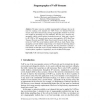Free Online Productivity Tools
i2Speak
i2Symbol
i2OCR
iTex2Img
iWeb2Print
iWeb2Shot
i2Type
iPdf2Split
iPdf2Merge
i2Bopomofo
i2Arabic
i2Style
i2Image
i2PDF
iLatex2Rtf
Sci2ools
CORR
2008
Springer
2008
Springer
Steganography of VoIP streams
The paper concerns available steganographic techniques that can be used for creating covert channels for VoIP (Voice over Internet Protocol) streams. Apart from characterizing existing steganographic methods we provide new insights by presenting two new techniques. The first one is network steganography solution which exploits free/unused protocols' fields and is known for IP, UDP or TCP protocols but has never been applied to RTP (Real-Time Transport Protocol) and RTCP (Real-Time Control Protocol) which are characteristic for VoIP. The second method, called LACK (Lost Audio Packets Steganography), provides hybrid storage-timing covert channel by utilizing delayed audio packets. The results of the experiment, that was performed to estimate a total amount of data that can be covertly transferred during typical VoIP conversation phase, regardless of steganalysis, are also included in this paper.
CORR 2008 | Covert Channel | Education | Network Steganography Solution | Real-time Transport Protocol |
| Added | 24 Jan 2011 |
| Updated | 24 Jan 2011 |
| Type | Journal |
| Year | 2008 |
| Where | CORR |
| Authors | Wojciech Mazurczyk, Krzysztof Szczypiorski |
Comments (0)

